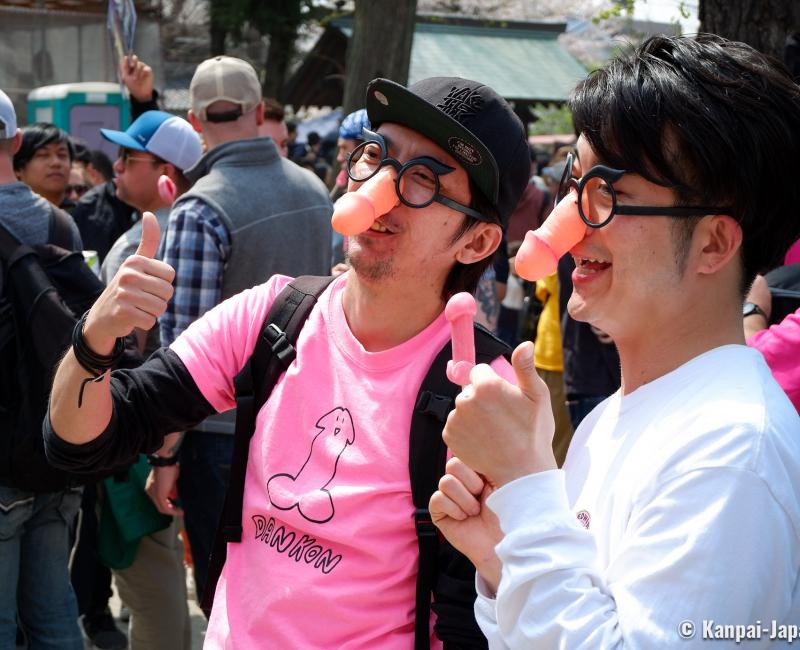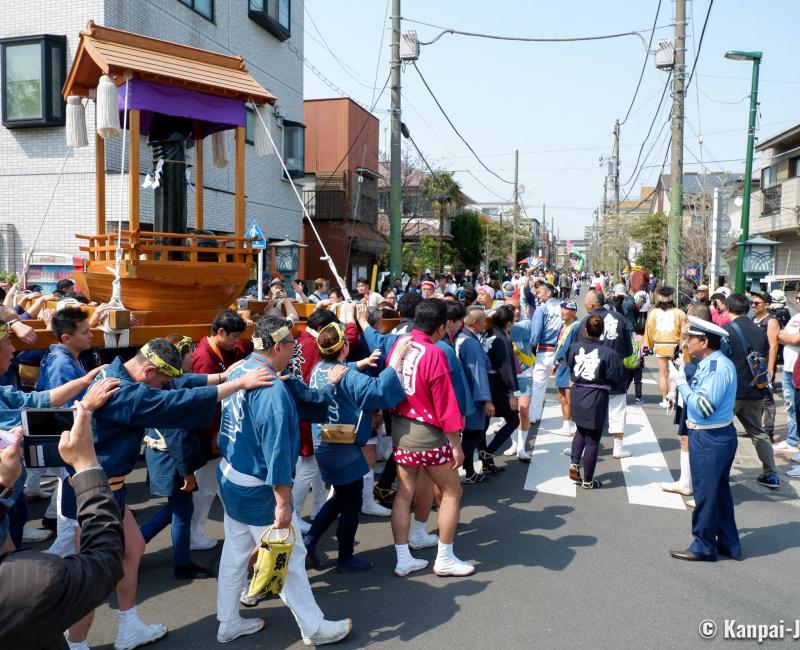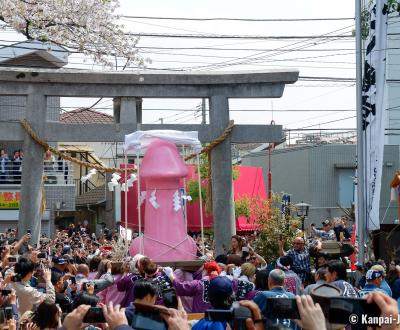Kanamara Matsuri
The Fertility Festival at Tokyo’s Doorstep 🍆
Kanamara Matsuri is a yearly Shinto festival dedicated to fertility, held in Kanayama shrine in Kawasaki, a city located between Tokyo and Yokohama. It is also known under the vernacular name of “penis festival” and attracts each year a growing number of foreign visitors searching for unusual experiences in Japan. It is held on the first Sunday of April, during Japanese cherry blossoms’ peak season.
The kami worshipped in Kanayama-jinja are Hiko and Hime, a godly couple protecting blacksmiths and sexuality. They are also in charge of family and procreation: they receive prayers to bless a marriage, for harmonious marital relationships, to have children and a safe delivery. Both Hiko and Hime are said to have appeared when Izanami, the primordial goddess, gave birth to the god of fire. They healed her burns, and thus also became protector gods against diseases affecting the lower part of the body and especially genital organs.
Kanayama-jinja’s founding originates from an ancient Japanese legend: a demon was in love with a woman and hid in her vagina. Twice the extremely jealous demon bit the men who tried to consummate their marriage with the woman. To get rid of this curse, the woman sought the help of a blacksmith who crafted a steel phallus with which the demon’s teeth were broken. Nowadays, this legend is illustrated with a reconstitution of a blacksmith shop and its anvil in the shrine’s grounds, as well as the many representations of the male organ and the vernacular name of the place, Kanamara-sama, which literally means "iron penis."
A peculiar festival with painful origins
More recently, during Edo period (1603-1868), the city of Kawasaki was spreading along the Tokaido, the main road connecting Edo the eastern capital (former name of Tokyo) to Kyoto. It is said that women working in the road’s inns, as well as servants and prostitutes, came to Kanayama shrine to pray for protection against diseases and infortune.
These customs have lasted up to our times and people affected by venereal diseases still came to pray at night in the shrine. It spurred Kanayama shrine’s worshippers to hold a festival to which anyone could participate in broad daylight without discrimination. It is now organized every spring, on the first Sunday of April and attracts about 30,000 persons, of which 60% are foreign visitors, a number that increases each year.

How to best enjoy Kanamara Matsuri?
It is best to arrive early in the morning, before the crowd gathers in the limited space around and in the shrine’s grounds. The first mikoshi processions start at 11:30, and arriving early allows to immerse in the spring festival’s atmosphere and visit the handful of stalls mainly set in the shrine’s grounds. As a matter of fact, entrance is allowed after a waiting line, another reason to arrive early and avoid wasting time.
In the shrine’s grounds, food stalls sell affordable specialty dishes, but also a large array of items shaped as male and female genital organs, including mochi pastries or sugar lollipops. As in every shrine, there is an Ema-den in Kanayama-jinja, a pavilion where worshippers hang ema votive plates on which they have written a wish to the kami. The building here features a characteristic decoration of wood phalluses on the top of the fences, and a large collection of ema plates, whose back are adorned with explicit illustrations. The nickname "penis festival" is well earned for Kanamara Matsuri as the male organ is omnipresent in every detail of the decoration and animations, and of course, in the surprising showstoppers: the mikoshi portable floats.
Three mikoshi floats are exhibited in the shrine’s grounds before the beginning of the procession, and that contributed to the popularity of the "willy festival":
- Dai-mikoshi (the "big mikoshi") is the oldest of the three, and looks like a square shape covered by a roof. It shelters an erected wood penis.
- Fune-mikoshi (the "mikoshi boat") as its name states, is a boat topped by a roof and sheltering a black iron penis. It is an offering from industrial company Hitachi Zosen that used to manufacture ships.
- Elizabeth-mikoshi ("Elizabeth’s mikoshi") is an eccentric giant pink penis, offered by a transvestites’ club in Asakusa-bashi, known under the name of Elizabeth Kaikan ("Elizabeth House"). Unlike the first two other, that are usually carried by the neighborhood’s men, Elizabeth-mikoshi was carried by the club’s transvestites in their work attire. As the transvestites have aged, the object was placed on a wheeled float, and since 2017 it is protected under a white canopy.

Party atmosphere in Kawasaki’s historical district
The festive atmosphere in Kanayama-jinja’s grounds is highlighted by little concerts and worshippers’ speeches to recall the necessity of producing offsprings to fight Japan’s current ageing demographics. A popular attraction offers to carve big white daikon radishes into an explicit shape. It is also possible to stroll in the surrounding streets with a lollipop shaped as male or female genitalia and walk into other very lively areas, in the same exuberant ambiance as in the shrine’s grounds.
The beautiful Kawasaki Daishi temple also has its usual quietness disrupted. Daishi garden next to the temple is an important stop for the mikoshi procession as it takes a break here for lunchtime, before resuming in the middle of the afternoon to come back to the shrine.
Despite the crowd, the matsuri unfolds without excesses. Some of the mikoshi holders don fancy disguises, and some visitors come fully dressed in Japanese traditional clothes. It is still necessary to behave appropriately as anywhere in Japan. The event is rather convivial, and some visitors come with family and young children, something we do not especially recommend.

